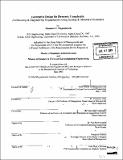Enterprise design for dynamic complexity : architecting & engineering organizations using system & structural dynamics
Author(s)
Piepenbrock, Theodore F. (Theodore Frederick), 1965-
DownloadFull printable version (77.12Mb)
Other Contributors
Leaders for Manufacturing Program.
Advisor
Charles H. Fine and Deborah J. Nightingale.
Terms of use
Metadata
Show full item recordAbstract
As the business world is neither linear nor static, the mastery of its "chaotic" nonlinear dynamics lies at the heart of finding high-leverage policies that return uncommon benefits for marginal costs. Today's global enterprises are dynamically complex socio-technical systems where cause and effect of management's strategies and policies are distant in space and time. Spatial complexity recognizes that correctly defining the limits of the extended enterprise is essential in maximizing shareholder value via stakeholder management. Temporal complexity recognizes that policies, decisions, structure and delays are interrelated to influence growth and stability. An enterprise's long-term success therefore is a function of management's ability to control this "dynamic complexity". The goal of this thesis is to develop management insights into "enterprise design", i.e. to create more successful management policies and organizational structures. Enterprise design can be decomposed into the science and art, or engineering and architecting. Using the heretofore-separate academic fields of system dynamics and structural dynamics, an attempt is made to define the scientific "laws" of enterprise physics that will then be used to construct non-obvious, often counter-intuitive enterprise architectures. The goal is to combine the methodologies from the "business of building" with the "building of business", in an attempt to draw lessons from the design of high-rise buildings for the design of high-rising enterprises. Throughout this thesis, examples of a variety of socio-technical enterprises are discussed in order to explore and test the principles and insights developed herein. There is however a unifying case study (cont.) used throughout of one of the world's most dynamically complex socio-political-technical enterprises: the Commercial Airplanes enterprise of The Boeing Company. This thesis uses the approaches of system and structural dynamics to explore Boeing's stability, growth, market share and profitability.
Description
Thesis (M.B.A.)--Massachusetts Institute of Technology, Sloan School of Management; and, (S.M.)--Massachusetts Institute of Technology, Dept. of Civil and Environmental Engineering; in conjunction with the Leaders for Manufacturing Program at MIT, 2004. Vita. Includes bibliographical references (v. 2, leaves 291-308).
Date issued
2004Department
Leaders for Manufacturing Program at MIT; Massachusetts Institute of Technology. Department of Civil and Environmental Engineering; Sloan School of ManagementPublisher
Massachusetts Institute of Technology
Keywords
Sloan School of Management., Civil and Environmental Engineering., Leaders for Manufacturing Program.